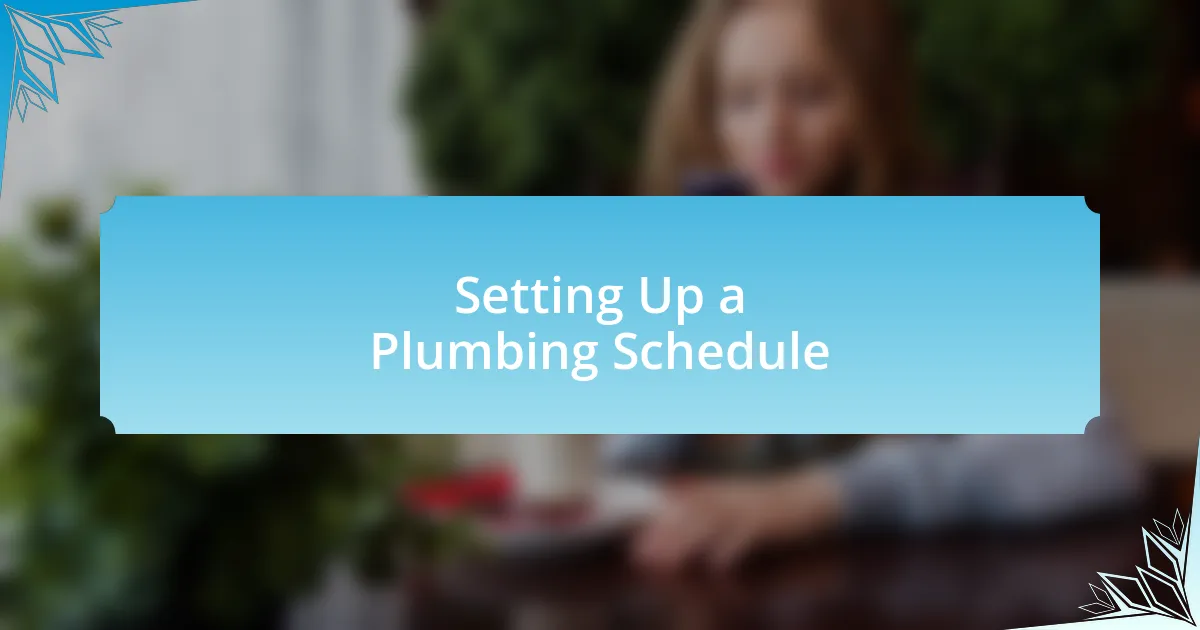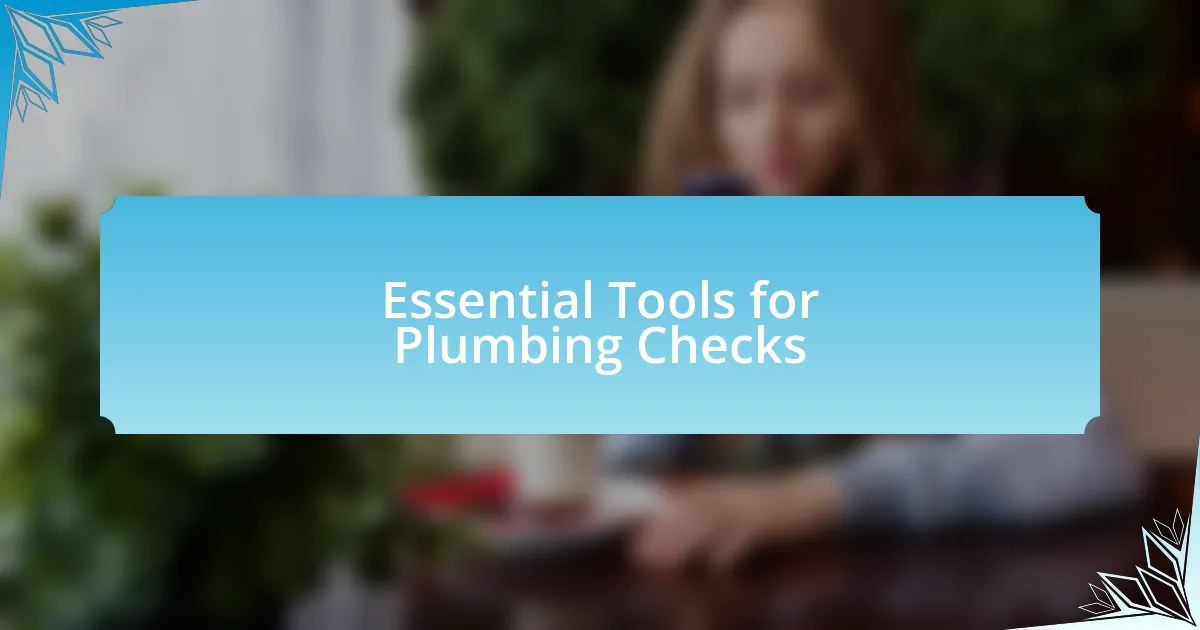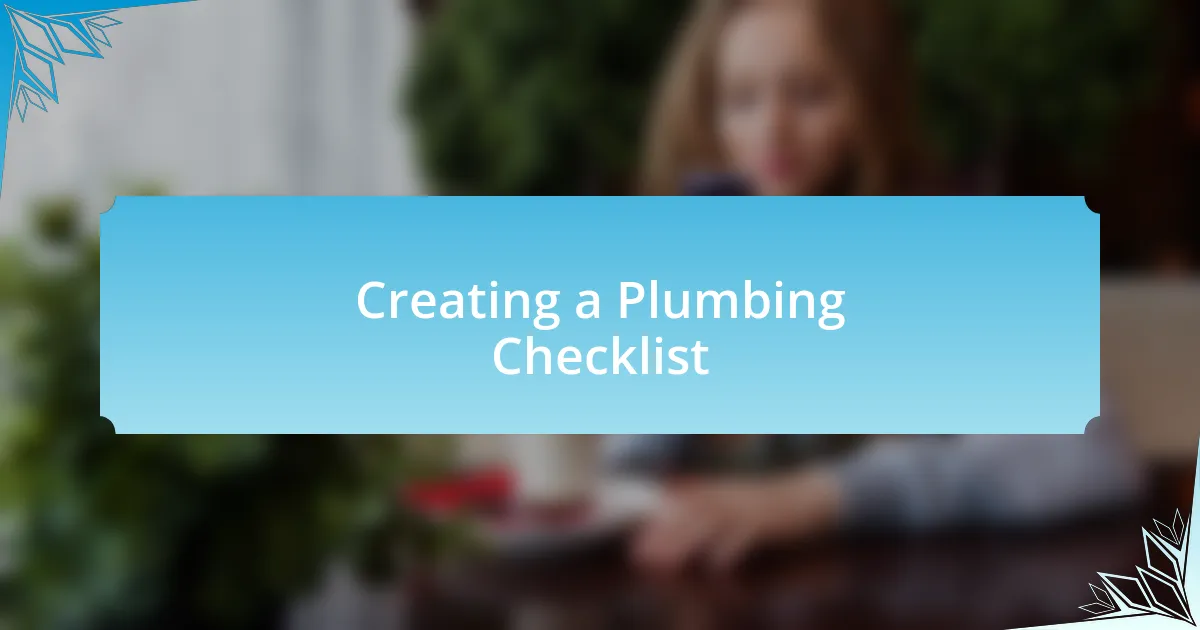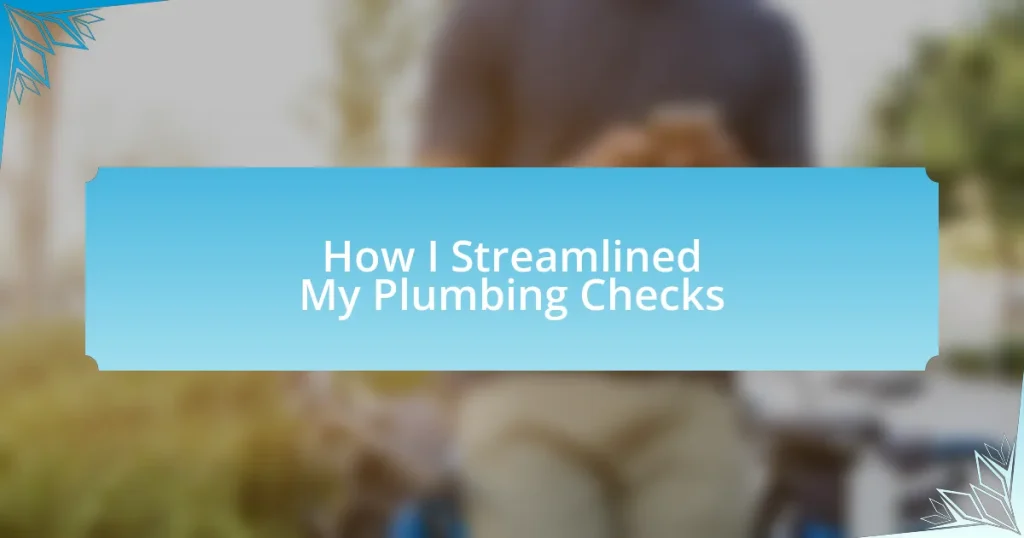Key takeaways:
- Regular plumbing inspections can prevent minor issues from escalating into major problems and save on repair costs.
- Establishing a routine maintenance schedule enhances understanding of plumbing systems and ensures timely detection of leaks or clogs.
- Utilizing essential tools, such as adjustable wrenches and pipe inspection cameras, is vital for effective plumbing checks.
- Documenting findings and analyzing them over time allows for identifying patterns, leading to more proactive home maintenance.

Understanding Plumbing Inspections Importance
Plumbing inspections are crucial for spotting potential issues before they escalate into major problems. I recall a time when a small leak turned out to be a precursor to a much larger plumbing headache. Had I scheduled regular inspections then, I could have avoided not just the mess but also the hefty repair bill that followed.
Understanding the importance of these inspections often brings to mind the notion that “an ounce of prevention is worth a pound of cure.” It’s a sentiment I deeply resonate with, especially after realizing how beneficial it is to have a trained professional assess my plumbing systems regularly. Each time I have my plumbing checked, I feel a sense of relief knowing I’m investing in my home’s safety and longevity.
Moreover, think about this: how often do we overlook the little things? Just like we schedule routine check-ups for our health, our plumbing needs the same level of attention. It certainly doesn’t hurt to know that with every inspection, I’m protecting my home from unexpected emergencies, and that’s a peace of mind worth striving for.

Setting Up a Plumbing Schedule
Setting up a plumbing schedule is all about consistency and awareness. I realized early on that a well-structured schedule could save me a ton of stress. For instance, I decided to inspect my plumbing systems every six months, aligning it with the change of seasons. This timing also reminded me of other maintenance tasks around the house, such as checking the furnace in autumn.
Taking the time to create a reliable routine not only keeps my plumbing in check but also enriches my understanding of how my home functions. I remember the first time I followed my schedule diligently; I discovered a small leak I had ignored. By addressing it promptly, I safeguarded my bathroom from potential water damage. It’s astonishing how a simple schedule can pave the way for a more proactive approach to home maintenance.
When setting up your plumbing checks, consider using a visual calendar where you can mark your inspection dates. This has been incredibly helpful for me, as I often forget specific tasks on my to-do list. Plus, seeing those dates prevents me from pushing them aside, making plumbing care just another part of my routine.
| Frequency | Benefits |
|---|---|
| Every 3 Months | Early detection of issues; regular monitoring. |
| Every 6 Months | Ideal for seasonal checks; reinforces maintenance habits. |
| Annually | Comprehensive review; prepares for potential seasonal stress. |

Essential Tools for Plumbing Checks
To efficiently tackle plumbing checks, having the right tools is crucial. Over the years, I’ve gathered a trusty toolkit that allows me to inspect and address minor issues before they escalate into major problems. I recall the first time I attempted a DIY plumbing task. Armed with only a basic wrench, I found myself frustrated when I couldn’t properly tighten a leaky connection. That experience taught me the importance of being equipped with a comprehensive set of tools.
Here’s a list of essential tools that I recommend for conducting your plumbing checks:
- Adjustable wrench: Perfect for gripping and turning various plumbing components.
- Plumber’s tape: Helps create watertight seals on threaded fittings.
- Basin wrench: Ideal for tight spaces, making it easier to reach difficult angles.
- Pipe inspection camera: Provides a close-up view of your pipes, revealing hidden issues.
- Plungers: A must-have for clearing minor clogs quickly and easily.
- Utility knife: Useful for cutting through pipes or other materials when necessary.
- Bucket: Essential for catching any residual water during inspections.
These tools don’t just facilitate the process; they instill confidence. I remember my first plumbing inspection after assembling this toolkit. I approached each check with a sense of preparedness, knowing I had the necessary equipment on hand to handle unexpected setbacks.

Creating a Plumbing Checklist
Creating a plumbing checklist is a vital step that ensures I don’t overlook any important details during my inspections. When I first started, I often missed smaller tasks, which would later lead to bigger headaches. To combat this, I drafted a simple checklist that includes all the essential areas to inspect, such as faucets, drains, and visible pipes.
What really makes my checklist useful are the notes I add about each component. For example, I track how often I’ve noticed dripping in the kitchen faucet or the sound of running water from the toilet. These personal touchpoints not only help me remember what to check but also provide insights into potential problems that might require my attention sooner rather than later.
I also encourage making the checklist a living document. Each time I complete a plumbing check, I jot down findings and observations. This habit has transformed my approach to plumbing; it fosters a sense of responsibility and accountability. Have you ever thought about how your routine could benefit from a similar practice? It’s those small changes that can lead to big improvements over time.

Tips for Efficient Inspections
When it comes to efficient inspections, I’ve found that timing truly matters. Scheduling my inspections at regular intervals has become a game-changer for me. Initially, I let repairs pile up until urgent problems forced my hand, which led to unnecessary stress and expense. Now, I set reminders on my calendar to check my plumbing systems every few months. It’s simple, but it keeps me ahead of the curve.
I’ve also learned the value of using the right tools to make my inspections smoother. Early on, I used just a flashlight and my phone for notes, which often left me frustrated. Now, I carry a small inspection camera to check hard-to-reach areas. Not only does this save time, but it also helps me identify issues I could easily miss otherwise. Have you considered what tools might enhance your inspections? They could save you not just time but also money in the long run.
Another tip that has paid off is involving other family members in the process. I used to handle everything myself, but now I’ve included my children in simple tasks, like checking the outdoor faucet. This not only makes it a family bonding activity but also teaches them the importance of home maintenance. What might happen if you opted to share responsibilities? You could foster a sense of teamwork, and everyone would be more aware of plumbing issues, leading to a proactive approach rather than a reactive one.

Common Plumbing Issues to Monitor
When I think about common plumbing issues to monitor, leaky faucets come to mind first. I once ignored a small drip, thinking it was insignificant, but soon realized that a few drops here and there can quickly add up to gallons of wasted water. Have you faced a similar scenario? Regularly checking for leaks can save not just water, but also reduce your water bill—why let those pennies slip away?
Another issue I’ve encountered is slow drains. I remember a time when my kitchen sink took forever to empty, and I just assumed it was a minor inconvenience. However, that sluggishness was the result of grease buildup, which needed my attention. Now, I make a habit of pouring a mixture of baking soda and vinegar down my drains every few months to keep them clear. It’s a small effort that prevents larger headaches down the line.
Finally, I can’t stress enough the importance of monitoring your water heater. Mine once started making strange noises, and rather than ignore it, I investigated right away. It turned out that sediment buildup had begun to impact efficiency. Regularly flushing your water heater not only helps it run more smoothly but also extends its lifespan significantly. Isn’t it better to invest a little time now than to face a costly replacement later?

Documenting and Analyzing Findings
When it comes to documenting my plumbing findings, I’ve found that jotting everything down helps me stay organized. I use a simple spreadsheet to track issues like leaks or blockages over time, noting when I first noticed a problem and what steps I took next. This method not only provides me with a reference point for future checks but also reveals patterns that might indicate deeper issues brewing beneath the surface. Have you ever considered how a small record can dramatically improve your understanding of your home’s plumbing?
Analyzing these findings gives me a clearer picture of the overall health of my plumbing system. For example, after a few months of recording slow drain instances, I noticed that all the trouble spots were concentrated in the kitchen. This realization prompted me to assess my cleaning habits and switch to regular maintenance methods. Trust me when I say, it’s rewarding to see how much preventive action can save you time and hassle later!
Reflecting on my records not only brings clarity but also transforms how I approach plumbing checks. I remember one winter when my water heater acted up repeatedly, and my notes revealed that the issue had been creeping up for months. Recognizing this was a pivotal moment for me; realizing I could’ve addressed it sooner made a big impact. How often do we overlook small signs that could lead to bigger problems? More importantly, documenting and analyzing helps me feel proactive rather than reactive in maintaining my home.
















